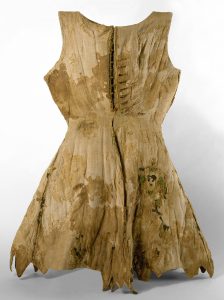
Gambeson
Author: Unknown
Date: 14th century, end
Material: Wool thread; polychromed silk thread; metallic golden thread | Lining: brown silk thread | Padding: linen thread; disentangled wool
Dimensions (cm): H 138 x W 99
Provenance: Guimarães, Colegiada de Nossa Senhora da Oliveira
Inventory No.: MAS T 5 (7)
The gambeson is one of the most emblematic pieces of the Museu de Alberto Sampaio. It was probably worn by Dom João I at the Battle of Aljubarrota, on 14 August 1385, and it was offered to Saint Mary of the Olive Tree by the monarch as a sign of gratitude for the victory attained in that royal battle.
This military piece of wear, composed of several layers of linen padded with wool, was externally coated with a green wool cloth embroidered with silk and gold thread. According to Fernão Lopes, it was also filled with vegetal motifs and crosses of Saint George. Nowadays, only the vestiges of the escutcheon of Dom João I are visible, namely the four extremities of the cross of Avis.
This was a light piece of clothing that allowed great mobility and that was worn over the coat of mail. Over it, they could wear loose pieces of the armour.
Although it was a piece of clothing that protected the body (from the armour itself and from the enemies’ strokes), the gambeson was also used to identify the person who wore it. At Aljubarrota, according to Maria Emília Amaral Teixeira, the Portuguese wore gambesons with the cross of Saint George, their patron saint, and the Castilians wore gambesons with the cross of Saint James. Fernão Lopes mentions that, after the battle had been won by the Portuguese, the Castilians ran away and put their gambesons with the inside out to avoid being identified. When describing the encounter between Dom João I and the Duke of Lancaster, Fernão Lopes also records that the king “… gave all those who accompanied him, who should be nearly five hundred spears, gambesons of white fustian with crosses of Saint George…”.
This is one of the rarest military pieces of wear from the 14th century existing in the world. There’s another one from this period that belonged to the oldest son of King Edward III of England, the Black Prince, who was the uncle of Dona Filipa de Lencastre, Dom João I’s wife.
The Portuguese consider it a relic and it was classified as a national treasure in 2006, by the Decree no. 19/2006, from 18 July, and respective declaration of ratification no. 62/2006, from 15 September.
